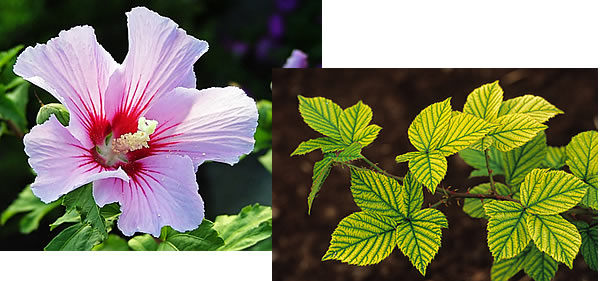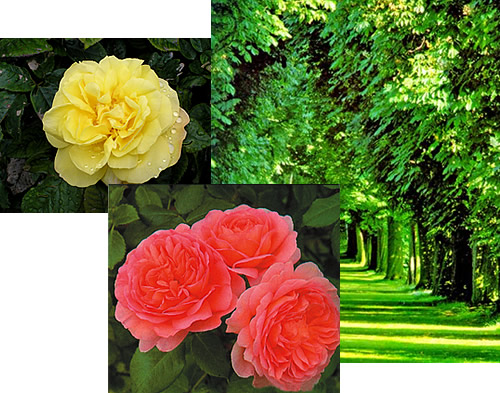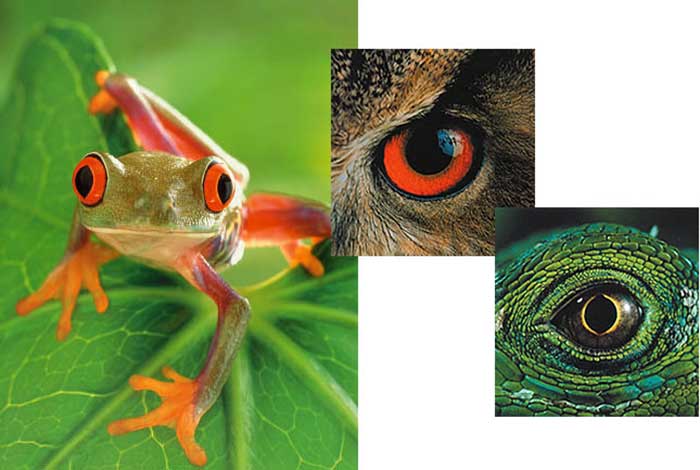Molecules that Produce Colour : Pigments
In previous chapters, we mentioned that because of the different atomic properties of the pigmentary molecules, objects reflect light rays differently; hence, different shades of colour are produced. Have another look around you. The different colours in your range of vision indicate the existence of a similar number of pigments, because the colour of everything we see in our surroundings depends on the pigments present in the composition of that matter. The green colour of plants, the colour of skin, the colours of animals, in short all colours stem from the structural characteristics of the pigments contained in those objects or living things.
What is Pigment?
Pigments, existing both in our eyes and in the outer surface of objects, are special molecules that bring about colour. A certain energy is needed for pigment molecules to be activated. Certainly, just as in all other stages in the formation of colour, there is again perfect harmony between pigments and light. "The invisible light" reaching the earth has been specially designed for the "pigment" molecules, which are known as colour molecules, in living things.
Moreover, human eyes also have a structure compatible to this purpose. The reason why the cone cells that lie in the retina of our eye perceive three main colours – red, green, and blue – is because of the special pigment molecules they contain. The most crucial task these pigments perform so that we see a coloured world is convert the energy of "colour" in light into nerve impulses. This means that everything we know as colour is an end-result of these pigments transmitting the wavelength of light reaching to them to the brain as nerve impulses.11
 |
| The reason for colour diversity in the leaves of flowers is the reaction to light of pigment molecules present in their structure. |
The energy levels of visible light correspond to some of the energy levels needed for activating pigment molecules that are found in the skins of living beings, or in the scales, feathers, or furs covering their skins, and thus their colours are formed.
As seen, pigments, which are present both in the vision centres and in the bodies of living beings, are in perfect harmony with other bodily systems. Absence of a particular kind of pigment molecule or its presence in an amount less than required in the vision centre of a living being causes it to be unable to distinguish colours in its environment.
The question is: how do these special molecules develop in the skins of living beings? We can give an answer to this question by asking some further questions. Have living beings come to possess these colours by acknowledging the properties of a special light spectrum reaching the earth and choosing special pigment molecules accordingly? Certainly the possibility of the occurrence of such a coincidence is zero. These specific molecules have been placed in the skin of living beings by conscious design. It is obvious that neither could living beings carry out such a process, nor could random coincidence bring about such a formation. The harmony in question is one, which could only come about because of One Who Wills creating it, One Who keeps everything under control. Allah has created each living being with very sophisticated characteristics peculiar to it. Everything, animate or inanimate, has pigments suitable to it. Pigments absorb light selectively according to their molecular structure. Every pigment does not react to light in the same way. For this reason, it cannot set off the same chemical reaction and form the same colour.
We can give chlorophyll, the pigment molecule that causes plants to look green, as an example. These pigments absorb certain wavelengths coming from the sun and reflect light having the wavelength that corresponds to green colour. Chlorophylls, the pigment molecules in plants, reflect the photons that look green due to their wavelengths. At the same time, the energy they receive from sunlight enables the plants to produce carbohydrates, one of the prime food sources of all living beings.12 Different pigment molecules reflect particular colours at certain wavelengths according to their own molecular properties and hence cause different chemical reactions.
There are many kinds of pigments in nature. A few examples are sufficient to show that pigment molecules have been specially designed for life.
Examples of Pigment Types /Protective Colour Source: Melanin
 |
| The pigment chlorophyll existing in plants is dominant over other pigments. Therefore, plants look green. |
The eyes of living beings are quite sensitive to light and are easily affected adversely. Still, we can safely look towards the sun and see our surroundings, thanks to the support systems Allah specially created. One of these support systems is a group of pigment molecules present in the eye.
As is well known, the colours of living beings' eyes vary. What give an eye its colours are, again, pigments. Melanin is one of these pigmentary substances present in the eye that gives the eye its colour. The same pigment also gives your skin and hair their colours. However, melanin provides more than colour. Researchers believe that melanin, which exists in the eye, offers both protection against the deleterious effects of sunrays, and vision enhancement. The substance melanin, nature's solution to the problem of hazardous light rays, absorbs higher energy light more strongly than lower energy light. So, it absorbs ultraviolet more strongly than blue, and blue more strongly than green.13 In this way, melanin provides protection to the lens of the eye against ultraviolet. It provides near optimum protection to the retina by filtering different colours in proportion to their ability to damage the tissue of the retina – thereby reducing the risks of macular degeneration. People with more eye-melanin have less occurrence of macular degeneration; people with less eye-melanin have greater occurrence of macular degeneration. About 15% of our original supply of melanin is lost from the eye by the age of forty and about 25% is lost by the age of fifty. The role melanin plays in eye protection is critical: ophthalmologists report that melanin in the eye reduces the risk of age-related macular degeneration.14
 | |
| 1. Blue reflected by pigment | |
| Left: The light rays coming from the sun activate the pigments in the objects and therefore colours form. We may compare pigment molecules to sieves whose selectivity depends on the size of their pores. Just as in a sieve, the wavelengths which pigments select according to their structures – that means colours – vary. | Right: Blood contains colourful pigments carrying oxygen in the body. These colours vary among living beings. For instance, while the colour of the blood of cuttlefish is light blue or colourless, the blood pigments of other animals and human beings are red. The redness of the hen's crest and the redness of most shrimps are caused by blood pigments. |
As understood, each one of the functions of the substance melanin demonstrates to us the special design of this substance. The answer to the question of how such a perfect substance has come about is that it is impossible for such a multifunctional substance with such a perfect structure to have come into being by coincidence. Allah has created the substance melanin, like all other things in the universe, in a special way as to serve a beneficial purpose for people.
 |
| The big red eyes of the frog send warning signals to its predators. The reptile's eyes seen above have a colour that does not offset the camouflaging of the reptile. The eye of the owl on the right has a colour exclusive to its kind. |
The Source of Lively Colours
 |
| The sources of the lively colours present in the beaks of toucans are also pigmentary molecules. |
Carotenoids (and lipochromes) are pigmentary molecules, which are synthesised by plants and which reflect the colours yellow, red and orange. Animals can obtain these pigments only by feeding on plants.
Poisonous sponges, crinoidea, toxic sea-cucumbers and some molluscs are either partly or completely yellow, red or orange in colour as a result of carotenoids, which are also present in the yellow parts of butterflies' wings and in the beaks of birds. In certain insects, these are emitted by special glands, which are yellow or red in colour. Curiously, these compounds are usually pale green or even colourless and only take on a bright yellow colour in the blood of poisonous insects. The carotenoids are not only useful as warning coloration; in some insects they are themselves transformed into poisonous compounds, in which case they serve a twofold purpose of being both a weapon and a signal.15 By means of this very special system that Allah has created, many living beings continue to thrive.
Thus far, we have briefly examined only a few types of pigment existing in nature. The conclusion we have reached in light of this review is the presence of the perfect design that reveals itself in pigments, in the atoms forming these pigments and in all the resulting colours. Allah, the ultimate Owner of this exceptional design, Lord of the worlds, introduces Himself to us by the unique artistry in the colours He creates in nature.
Have they not travelled about the earth and do they not have hearts to understand with or ears to hear with? It is not their eyes which are blind but the hearts in their breasts which are blind (Surat al-Hajj: 46)
Footnotes
10. Franklyn Branley, Color, From Rainbows to Lasers, Thomas Y. Crowell Comp., New York, p.23-28
11. Solomon, Berg, Martin, Villie, Biology, Saunders College Publishing, 1993, p.192-193
12. Temel Britannica Ansiklopedisi, Cilt 7, p.16
13. http://www.netxpress.com/~ppt/story.htm
14. http://www.netxpress.com/~ppt/story.htm
15. Marco Ferrari, Colors for Survival, Barnes and Noble Books, New York, 1992, p.110
